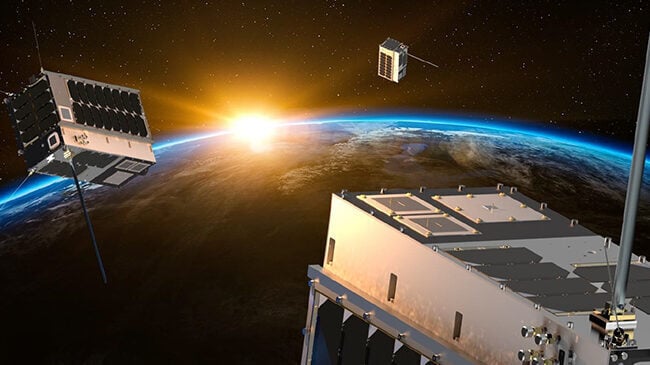
Hawkeye 360 RF geolocation satellites.
This report has been updated to note the draft RFP discussed below has been approved.
GEOINT 2021: The National Reconnaissance Office on Thursday released a call to commercial industry to pitch emerging remote sensing satellite technologies, starting with synthetic aperture radar (SAR) and eventually to be broadened to include radio-frequency, hyperspectral and even in future LiDAR sensors.
The move is a shift in the agency’s earlier plans to issue a formal request for proposals (RFP) to SAR providers, NRO officials said on Thursday.
The new acquisition effort is called the Broad Agency Announcement (BAA) Framework for Strategic Commercial Enhancements, and will allow NRO to use non-traditional contracting authorities to rapidly bring commercial companies on board. While BAAs and OTAs are widely used by the Defense Department, the Intelligence Community (IC) has been more leery — concerned about the legal issues that might arise with moving outside the Federal Acquisition Regulation (FAR).
NRO Director Chris Scolese told the GEOINT audience here in St. Louis, “One of the reasons we went with a BAA is that it allows us to evaluate faster, to move faster.”
Furthermore, not only will the application process be open to US industry, but also foreign-owned US companies. This comes as a bit of a surprise, given that NRO’s June draft RFP for commercial electro-optical sensors explicitly barred foreign-owned firms from competing.
However, the head of NRO’s Commercial Systems Program Office, Pete Muend, told reporters on Thursday that the BAA doesn’t necessarily signal that the acquisition strategy laid out in the draft RFP for the Electro Optical Commercial Layer program is changing.
“It is a case-by-case assessment, depending on what the requirements are and a variety of other factors, of course,” Muend said. “So, you know really what we’re focused on here is with the BAA, and the radar focus area in particular, is getting an understanding of what broader industry can bring to bear, and so that cast a bit wider net, as opposed to, really defined requirements.”
That draft RFP has been approved by DoD and IC leaders, Muend’s deputy, Jeremy Banik, told the GEOINT symposium in a later talk. The goal is for the EOCL program to hit initial operating capability — when commercial imagery from chosen providers will be available for military users to download — in April 2022.
Muend explained that the BAA is “subsuming” NRO’s plan to put out a formal RFP for commercial SAR (a draft of which was released earlier this year) — as well as the study contracts it has signed with providers of emerging technologies. He added that the BAA also allows NRO to look at new entrants, with a plan in mind to offer multiple contracts.
NRO plans to release independent focus areas under the BAA multiple times per year.
In December 2019, NRO contracted with California SAR-sat startup Capella Space, as well as Hawkeye 360, a startup headquartered in Herndon, Va., which is building a constellation of radio frequency (RF) geolocation sats. ICEYE, a Finnish startup that was the first commercial firm to launch a SAR-sat in 2018, also has expressed interest in selling imagery to NRO.
NRO interest in LiDAR (light detection and ranging) sensors, which use active lasers to create images, is new. Commercial LiDAR for imaging is also a relatively young market, with LiDAR sensors largely being used to in navigation systems for rendezvous and proximity operations, which involve docking a spacecraft to a satellite for servicing, or for large-scale terrain mapping. For example, NASA signed a licensing agreement in August with Virginia-based Psionic, LLC, for the use of a NASA 3D LiDAR, called Kodiak.
“LiDAR is a really neat technology, and we’ve got to take advantage of it,” Scolese said.
HASC chair backs Air Force plan on space Guard units (Exclusive)
House Armed Services Chairman Mike Rogers tells Breaking Defense that Guard advocates should not “waste their time” lobbying against the move.



























